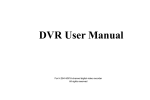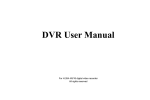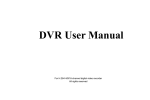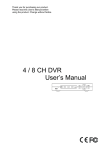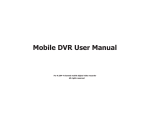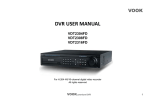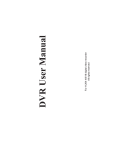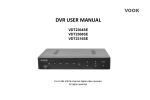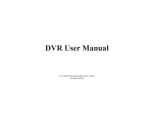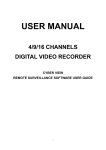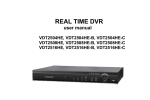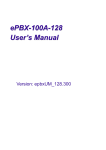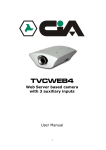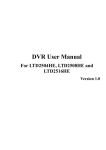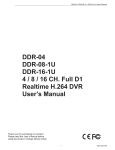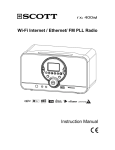Download pdf of user manual - Stark Electronics
Transcript
DVR User Manual For H.264 4/8-channel digital video recorder All rights reserved Digital Video Recorder User Manual CAUTION Please read this user manual carefully to ensure that you can use the device correctly and safely We do not warrant all the content is correct. The contents of this manual are subject to change without notice z This device should be operated only from the type of power source indicated on the marking label. The voltage of the power must be verified before using. If not in use for a long time, pull out the plug from the socket z Do not install this device near any heat sources such as radiators, heat registers, stoves or other device that produce heat z Do not install this device near water. Clean only with a dry cloth z Do not block any ventilation openings. And ensure well ventilation around the machine z Do not power off the DVR at normal recording condition! The correct operation to shut off DVR is to stop recording firstly, and then select “shut-down” button at the right of the menu bar to exit, and finally to cut off the power. z This machine is indoor using equipment. Do not expose the machine in rain or moist environment. In case any solid or liquid get into the machine’s case, please cut off the power supply immediately, and ask for qualified technicians to check the machine before restart z Refer all servicing to qualified service personnel. No any parts repaired by yourself without technical aid or approval. z This manual is suitable for 4/8-channel digital video recorders. All examples and pictures used in the manual are from 8-channel DVR. z z 2 Digital Video Recorder User Manual Table of Contents 1 2 3 4 Introduction...........................................................................................................................................................................7 1.1 DVR Introduction...............................................................................................................................................................7 1.2 Main Features ...................................................................................................................................................................7 Hardware Installation ..........................................................................................................................................................10 2.1 Install Hard Drive ............................................................................................................................................................10 2.1.1 Install Hard Drive....................................................................................................................................................10 2.2 Front Panel Instructions .................................................................................................................................................. 11 2.3 Rear Panel Instructions...................................................................................................................................................12 2.3.1 Rear Panel Interface ..............................................................................................................................................12 2.4 Remote Controller...........................................................................................................................................................15 2.5 Control with Mouse .........................................................................................................................................................17 2.5.1 Connect Mouse ......................................................................................................................................................17 2.5.2 Use Mouse.............................................................................................................................................................18 Basic Function Instruction ..................................................................................................................................................20 3.1 Power On/Off ..................................................................................................................................................................20 3.1.1 Power on................................................................................................................................................................20 3.1.2 Power off ................................................................................................................................................................21 3.2 Login ...............................................................................................................................................................................21 3.3 Live preview ....................................................................................................................................................................22 3.3.1 Live playback .........................................................................................................................................................22 Main menu setup guide ......................................................................................................................................................24 4.1 Basic configuration..........................................................................................................................................................26 3 Digital Video Recorder User Manual 4.1.1 System ...................................................................................................................................................................26 4.1.2 Time & date............................................................................................................................................................27 4.1.3 DST........................................................................................................................................................................28 4.2 Live configuration............................................................................................................................................................29 4.2.1 Live ........................................................................................................................................................................29 4.2.2 SPOT .....................................................................................................................................................................30 4.2.3 Mask ......................................................................................................................................................................31 4.3 Record configuration .......................................................................................................................................................33 4.3.1 Enable....................................................................................................................................................................33 4.3.2 Record stream .......................................................................................................................................................34 4.3.3 Time .......................................................................................................................................................................36 4.3.4 Stamp.....................................................................................................................................................................37 4.3.5 Recycle record .......................................................................................................................................................38 4.4 Schedule configuration ...................................................................................................................................................38 4.4.1 Schedule ................................................................................................................................................................38 4.4.2 Motion ....................................................................................................................................................................40 4.4.3 Sensor....................................................................................................................................................................41 4.5 Alarm configuration .........................................................................................................................................................41 4.5.1 Sensor....................................................................................................................................................................41 4.5.2 Motion ....................................................................................................................................................................45 4.5.3 Video loss ..............................................................................................................................................................47 4.5.4 Other alarm ............................................................................................................................................................49 4.5.5 Alarm out................................................................................................................................................................49 4.6 Network configuration .....................................................................................................................................................51 4.6.1 Network..................................................................................................................................................................51 4 Digital Video Recorder User Manual 5 6 7 4.6.2 Sub stream.............................................................................................................................................................52 4.6.3 Email ......................................................................................................................................................................54 4.6.4 Other settings.........................................................................................................................................................55 4.7 User management configuration .....................................................................................................................................58 4.8 P.T.Z configuration ..........................................................................................................................................................59 4.9 Reset ..............................................................................................................................................................................64 Record search & playback and backup ..............................................................................................................................65 5.1 Time search ....................................................................................................................................................................65 5.2 Event search ...................................................................................................................................................................66 5.3 File management ............................................................................................................................................................67 5.4 Backup ............................................................................................................................................................................68 Manage DVR ......................................................................................................................................................................70 6.1 Check system information...............................................................................................................................................70 6.1.1 System information ................................................................................................................................................70 6.1.2 Event information ...................................................................................................................................................70 6.1.3 Log information ......................................................................................................................................................71 6.1.4 Network information ...............................................................................................................................................72 6.1.5 Online information ..................................................................................................................................................72 6.2 Disk management ...........................................................................................................................................................73 6.3 Upgrade ..........................................................................................................................................................................73 6.4 Logoff ..............................................................................................................................................................................73 Remote Surveillance ..........................................................................................................................................................74 7.1 Accessing DVR ...............................................................................................................................................................74 7.1.1 On LAN ..................................................................................................................................................................74 7.1.2 On WAN .................................................................................................................................................................75 5 Digital Video Recorder User Manual 8 7.2 The remote live preview interface as below: ...................................................................................................................77 7.3 Remote playback & backup ............................................................................................................................................81 7.3.1 Remote playback ...................................................................................................................................................81 7.3.2 Remote backup ......................................................................................................................................................86 7.4 Remote System configuration .........................................................................................................................................87 Mobile Surveillance ............................................................................................................................................................88 8.1 By Phones with Windows mobile ....................................................................................................................................88 8.2 By Phones with Symbian ................................................................................................................................................91 8.3 The operation method for iPhone mobile clients .............................................................................................................94 8.4 The installation & operation methods for Android mobile clients .....................................................................................99 Appendix A FAQ………………………………………………………………………………………………………………….......107 Appendix B Calculate Recording Capacity………………………………………………………………..……………………….112 Appendix C Compatible Devices…………………………………………………………………………………………………....113 Appendix D 4-CH DVR Specifications………………………………………………………………………………………………114 Appendix E 8-CH DVR Specifications………………………………………………………………………………………………115 6 Digital Video Recorder User Manual 1 Introduction 1.1 DVR Introduction This model DVR (Digital Video Recorder) is designed specially for CCTV system. It adopts high performance video processing chips and embedded Linux system. Meanwhile, it utilizes many most advanced technologies, such as standard H.264 with low bit rate, Dual stream, SATA interface, VGA output mouse supported, IE browser supported with full remote control, mobile view(by phones), etc., which ensure its powerful functions and high stability. Due to these distinctive characteristics, it is widely used in banks, telecommunication, transportation, factories, warehouse, and irrigation and so on. 1.2 Main Features COMPRESSION FORMAT • Standard H.264 compression with low bit rate and better image quality LIVE SURVEILLANCE Support HD VGA output Support channel security by hiding live display Display the local record state and basic information Support USB to make full control • • • • RECORD MEDIA Support two SATA HDD to record for a longer time without any limitation • 7 Digital Video Recorder User Manual BACKUP Support USB 2.0 devices to backup Support saving recorded files with AVI standard format to a remote computer through internet • • RECORD & PLAYBACK • Record modes: Manual, Schedule, Motion detection and Sensor alarm recording • Support recycle after HDD full • Resolution, frame rate and picture quality are adjustable • 128MB for every video file packaging • 4/8 audio channels available • Two record search mode: time search and event search • Support deleting and locking the recorded files one by one • Support remote playback in Network Client through LAN or internet ALARM 1 channel alarm output and 4/8 channel alarm input available Support schedule for motion detection and sensor alarm Support pre-recording and post recording Support linked channels recording once motion or alarm triggered on certain channel Support linked PTZ preset ,auto cruise and track of the corresponding channel • • • • • PTZ CONTROL Support various PTZ protocols Support 128 PTZ presets and 8 auto cruise tracks Support remote PTZ control through internet • • • 8 Digital Video Recorder User Manual SECURITY Customize user right: log search, system setup, two way audio, file management, disk management, remote login, live view, manual record, playback, PTZ control and remote live view • Support 1 administrator and 15 users. • Support event log recording and checking, events unlimited • NETWORK Support TCP/IP, DHCP, PPPoE, DDNS protocol Support IE browser to do remote view Support setup client connection amount Support dual stream. Network stream is adjustable independently to fit the network bandwidth and environment. Support picture snap and color adjustment in remote live Support remote time and event search, and channel playback with picture snap Support remote PTZ control with preset and auto cruise Support remote full menu setup, changing all the DVR parameters remotely Support mobile surveillance by smart phones , symbian, WinCE, Iphone , Gphone, 3G network available Support CMS to manage multi devices on internet • • • • • • • • • • 9 Digital Video Recorder User Manual 2 Hardware Installation Notice: Check the unit and the accessories after getting the DVR. Please disconnect the power before being connected to other devices. Don't hot plug in/out 2.1 Install Hard Drive 2.1.1 Install Hard Drive Notice: 1. this series support one SATA hard drives. Please use the hard drive the manufacturers recommend specially for security and safe field. 2. Please calculate HDD capacity according to the recording setting. Please refer to “Appendix B Calculate Recording Capacity”. Step1: Unscrew and Open the top cover Step2: Connect the power and data cables. Place the HDD onto the bottom case as below. Fig 2.1 Connect HDD Step3: Screw the HDD as below. 10 Digital Video Recorder User Manual Note: For the convenience to install, please connect the power and data cables firstly, and then screw to fix. Fig 2.2 Screw HDD 2.2 Front Panel Instructions Notice: The front panel descriptions are only for reference; please make the object as the standard. Type Icon Name Description Item 1 REC MENU/+ BACKUP/Compound button SEARCH PLAY /PAUSE FF REW Record manually 1. Enter menu in live 2. Increase the value in setup 1. Decrease the value in setup 2. Enter backup mode in live Enter search mode 1. Enter play interface 2. Suspend playback Fast forward Rewind 11 Digital Video Recorder User Manual Item Type Icon Name STOP/ESC 2 Input button Direction button Multi-screen Enter button USB 3 4 USB port POWER POWER Description 1. Quit play mode 2. Exit the current interface or status Change direction to select items Change screen display mode like1/4/9 channel Confirm selection To connect external USB devices like USB flash, USB HDD for backup or update firmware; or connect to USB mouse Shot switch off 2.3 Rear Panel Instructions 2.3.1 Rear Panel Interface The rear Panel interface for 4-ch is shown as Fig 2.3: 12 Digital Video Recorder User Manual Fig 2.3 Rear Panel for 4-ch Item Name 1 2 3 4 5 6 7 8 9 10 11 Audio in Video in Audio out Video out P/Z K/B ALARM OUT + 5V and GND ALARM IN VGA port LAN 12 USB port Description 4 CH Audio input Video input channels from 1-4 Audio output, connect to the sound box Connect to monitor Connect to speed dome Connect to keyboard 1-ch relay output. Connect to external alarm +5 V and Grounding Connect to external sensor1-4 VGA output, connect to monitor Network port Connect USB mouse or connect external USB devices 13 Digital Video Recorder User Manual Item 13 Name Description DC12V POWER INPUT Tab 2.1 Definitions of Front Panel Buttons The rear Panel interface for 8-ch is shown as Fig 2.4: Fig 2.4 Rear Panel for 8-ch Item Name Description 1 2 3 4 5 6 Audio in Video in Audio out Video out P/Z K/B ALARM OUT 4 CH Audio input Video input channels from 1-8 Audio output, connect to the sound box Connect to monitor Connect to speed dome Connect to keyboard 7 1-ch relay output. Connect to external alarm 14 Digital Video Recorder User Manual Item 8 9 10 11 12 13 Name Description + 5V and GND +5 V and Grounding ALARM IN Connect to external sensor1-8 VGA port VGA output, connect to monitor LAN Network port USB port Connect USB mouse or connect external USB devices DC12V POWER INPUT Tab 2.2 Definitions of Front Panel Buttons 2.4 Remote Controller It uses two AAA size batteries and works after loading batteries as following: Step1: Open the battery cover of the Remote Controller Step2: Place batteries. Please take care the poles (+ and -) Step3: Replace the battery cover Notice: Frequently defect checking as following 1. Check batteries poles 2. Check the remaining charge in the batteries 3. Check IR controller sensor is mask If it still doesn't work, Please change a new remote controller to try, or contact your dealers The interface of remote controller is shown in Fig2.5 Remote Controller. 15 Digital Video Recorder User Manual Fig 2.5 Remote Controller Item Name 1 Power Button 2 INFOR Button 3 4 5 6 7 8 9 REC Button Digital Button Multi Screen Button SEARCH Button MENU Button ENTER Button Direction Button Function Soft switch off to stop firmware running. Do it before power off. Get information about the DVR like firmware version, HDD information To record manually Input digital or choose camera To choose multi screen display mode To enter search mode To enter menu To confirm the choice or setup Move cursor in setup or pan/title PTZ 16 Digital Video Recorder User Manual Item 10 Name 12 13 14 +/- Button Playback Control Button AUDIO Button Auto Dwell Button BACKUP Button 15 PTZ Control Button 11 Function To increase or decrease the value in setup To control playback, Fast forward/rewind/stop/single frame play To enable audio output in live mode To enter auto dwell mode To enter backup mode To control PTZ camera: Move camera/ZOOM/FOCUS/IRIS/SPEED control Operation processes with remote controller to control multi-DVR The device ID of the DVR is 0. When use of remote controller to control single DVR, it’s not necessarily to reset the device ID, user can do operation directly; when control multiple DVR with remote controller, please refer to below steps: Step1: Activate remote controller to control DVR: enable DVR: turn the IR sensor of the remote controller to the IR receiver that on the front panel, press the number key 8 twice, then input device ID (Range from: 0-65535; the default device ID is 0.) with other digital number: 0-9, after that, press ENTER button to confirm. Step2: User can check the device ID by enter into System configurationÆBasic configurationÆdevice ID. User also can set other DVRs with the same device ID. For more convenient to operate, we don’t recommend user to set the device ID too long. Step3: Cancel controller to control DVR: turn the IR sensor of the remote controller to the IR receiver that on the front panel, press the number key 8 twice, then input the device ID that needs to be cancelled from controlling, press ENTER button to confirm. After that, the DVR will not be controlled by remote controller. 2.5 Control with Mouse 2.5.1 Connect Mouse It supports USB mouse through the ports on the rear panel, please refer to Fig 2.5 Remote Controller. 17 Digital Video Recorder User Manual Notice: If mouse is not detected or doesn't work, check below steps: 1. Make sure the mouse plugs in the USB mouse port not the USB port 2. Change a mouse to try 2.5.2 Use Mouse The structure of the main menu is shown in Fig 2.5 Remote Controller. In live: Double-click left button on one camera to be full screen display. Double-click again to return to the previous screen display. Click right button to show the control bar at the bottom of the screen as Fig 2.5 Remote Controller. Here are all control and setup. Click right mouse again to hide the control bar. In setup: Click left button to enter. Click right button to cancel setup, or return to the previous. If want to input the value, move cursor to the blank and click. An input window will appear as Fig2.6. It supports digitals, letters and symbols input. Fig 2.6 Digital Numbers and Letters Input Window Users can change some value by the wheel, such as time. Move cursor onto the value, and roll the wheel when the value blinks. It supports mouse drag. I.e. Set motion detection area: click customized, hold left button and drag to set motion detection area. Set schedule: hold left button and drag to set schedule time 18 Digital Video Recorder User Manual In playback: Click left button to choose the options. Click right button to return to live mode. In backup: Click left button to choose the options. Click right button to return to previous picture. In PTZ control: Click left button to choose the buttons to control the PTZ. Click right button to return to live. Notice: Mouse is the default tool in all the operation below unless Exceptional indication. 19 Digital Video Recorder User Manual 3 Basic Function Instruction 3.1 Power On/Off Before you power on the unit, please make sure all the connection is good. 3.1.1 Power on Step1: connect with the source power; switch on the power button near the power port in the rear panel Step2: the device will be loaded, and the power indicator will display blue Step3: before start, a WIZZARD dialogue box will be pop-up (refer to below picture) and show some information about time zone and time setup. After the device power on, if there is no menu or only has live image display, user can long press ESC button to switch. Notice: this serial device can only display menu on VGA monitor or BNC monitor at one time, if there is live image display without menu display, please check up whether other device has menu display firstly, or long press ESC key to 20 Digital Video Recorder User Manual wait for login dialog box to appear. Long press ESC key can switch the output between BNC and VGA. 3.1.2 Power off User can power off the device by using remote controller、keyboard and mouse. By remote controller: Step1: press Power button, the Shut down window will appear, click OK, the unit will power off after a while. Step2: disconnect the power By keyboard and mouse: Step1: enter into Menu, then select “System Shut Down” icon, the Shut down window will appear Step2: click OK, the unit will power off after a while. Step3: disconnect the power 3.2 Login User can login and logout the DVR system. User cannot do any other operations except changing the multi-screen display once logout. Fig 3-1 Login Notice: the default user name and password is “admin” and 123456” The concrete operation steps for change password, add or delete user please refer to Fig 3.7 User management 21 Digital Video Recorder User Manual configuration for more details. 3.3 Live preview Fig 3-2 live preview interface The explanation of symbol in the live preview interface: symbol meaning symbol Green Manual record or time record Red Yellow Motion detection record Figure icon meaning Alarm record Move event 3.3.1 Live playback Click Play screen. button to playback the record. Refer to Figure3-3. User can do concrete operation by click the buttons on 22 Digital Video Recorder User Manual Fig 3-3 live playback 23 Digital Video Recorder User Manual 4 Main menu setup guide Click right mouse or press ESC button on the front panel, the control bar will display on the bottom of the screen, refer to Fig 4-1: Click the Fig 4-1 main menu toolbar icon beside the screen display mode, a channel select dialog will appear as below: Take 8-channel DVR for example: user can tick off channels form 1-ch to 8-ch at random to display the live pictures, 6 channels can be selected at most. Then click button to confirm the setting. Click Menu button, the interface will pop-up as Fig 4-2; press MENU button on the front panel or operate with remote controller also can display the main menu. 24 Digital Video Recorder User Manual Fig 4-2 system setup Click Setup icon will pop-up the configuration menu: 25 Digital Video Recorder User Manual 4.1 Basic configuration Basic configuration includes three sub menus: system、date& time and DST. 4.1.1 System Step1: enter into system configurationÆbasic configurationÆsystem; refer to Fig 4-3: Fig 4-3 basic configuration-basic Step2: in this interface user can setup the device name, device ID, video format, max online users, Video Output and language, Screensaver and so on. The definitions for every parameters display as below: Device name: the name of the device. It may display on the client end or CMS that help user to recognize the device remotely. Video format: two modes: PAL and NTSC. User can select the video format according to that of camera. Password check: enable this option, user needs to input user name and password can do corresponding operations with 26 Digital Video Recorder User Manual the relevant right in system configuration. Show system time: display time in live. Startup wizard: tick off this item, there will display an opening wizard with time zone and time setup information Max online uses: set the max user amount of network connection Video output: the resolution of live display interface, range from: VGA800*600、VGA1024*768、VGA1280*1024and CVBS Note: When switch between VGA and CVBS will change the menu output mode, please connect to relevant monitor. Language: setup the menu language. Note: after changed the language and video output, the device needs to login again. Screensaver: user can setup the screensaver interval time (30s, 60s, 180s, 300s), if there is no any operation within the setting period, the device will auto logout and return to Login interface. 4.1.2 Time & date Step1: enter into system configurationÆbasic configurationÆtime & date; refer to Fig 4-4: Fig 4-4 basic configuration-time & date 27 Digital Video Recorder User Manual Step2: set the date format, time format, time zone in this interface; user also can adjust system date manually Step3: click “default” button to resort default setting; click “apply” button to save the setting; click “exit” button to exit current interface. 4.1.3 DST Step1: enter into system configurationÆbasic configurationÆDST; refer to Fig 4-5: Fig 4-5 basic configuration-DST Step2: in this interface, enable daylight saving time, time offset, mode, start & end month/week/date, etc. Step3: click “default” button to resort default setting; click “apply” button to save the setting; click “exit” button to exit current interface. 28 Digital Video Recorder User Manual 4.2 Live configuration Live configuration includes three submenus: live, spot and mask. 4.2.1 Live In this interface, user can setup camera name, adjust colors: brightness, hue, saturation and contrast. Step1: enter into system configurationÆlive configurationÆlive; refer to Fig 4-6: Fig 4-6 live configurationÆlive Step2: tick off camera name; click “setting” button, a window will pop-up as Fig 4-7: 29 Digital Video Recorder User Manual Fig 4-7 live-color adjustment Step3: in this interface, user can adjust brightness, hue, saturation and contrast in live; click “default” button to resort default setting, click “OK” button to save the setting. Step4: user can setup all channels with same parameters, tick off “all”, then do relevant setup. Step5: click “default” button to resort default setting; click “apply” button to save the setting; click “exit” button to exit current interface. 4.2.2 SPOT Step1: enter into system configurationÆlive configurationÆSpot; refer to Fig 4-8: 30 Digital Video Recorder User Manual Fig 4-8 live configuration-SPOT Step2: select split mode: 1×1and channel Step3: dwell time: the time interval for a certain dwell picture display switching to next dwell picture display Step4: selected the split mode, then setup current picture group. Click button to setup the previous channel groups of dwell picture, click button to set the latter channel groups of dwell picture. Step5: click “default” button to resort default setting; click “apply” button to save the setting; click “exit” button to exit current interface 4.2.3 Mask User can setup private mask area on the live image picture, max threes areas. 31 Digital Video Recorder User Manual Fig 4-9 live configuration-mask Setup mask area: click Setting button, enter into live image to press left mouse and drag mouse to set mask area, refer to below picture. Click Apply button to save the setting. Delete mask area: select a certain mask area, click left mouse to delete that mask area, click Apply button to save the setting. Setup mask area 32 Digital Video Recorder User Manual Live image mask area 4.3 Record configuration Record configuration includes five sub menus: enable, record bitrate, time, recycle record and stamp. 4.3.1 Enable Step1: enter into system configurationÆrecord configurationÆenable; refer to Fig 4-10: 33 Digital Video Recorder User Manual Fig 4-10 record configuration-enable Step2: tick off record, audio and record time Step3: user can setup all channels with same parameters, tick off “all”, then to do relevant setup. Step4: click “default” button to resort default setting; click “apply” button to save the setting; click “exit” button to exit current interface. Definitions and descriptions of Record: Parameter Meaning Record Record switch of every channels Audio Enable live record audio 4.3.2 Record stream Step1: enter into system configurationÆrecord configurationÆrecord bit rate; refer to Fig 4-11: 34 Digital Video Recorder User Manual Fig 4-11 record configuration-record bit rate Step2: setup rate, resolution, quality Step3: user can setup all channels with same parameters, tick off “All”, then to do relevant setup. Step4: click “default” button to resort default setting; click “apply” button to save the setting; click “exit” button to exit current interface. Note: if the rate value set is over high the maximum resources of the device, the value will be adjusted automatically. Definitions and descriptions of Record stream: Parameter Meaning 35 Digital Video Recorder User Manual Rate Resolution Quality Range from: 1-30(NTSC)1-25(PAL) Support CIF and D1 The quality of recorded images. The higher the value is, the clearer the recorded image is. Six options: lowest, lower, low, medium, higher and highest. 4.3.3 Time Step1: enter into system configurationÆrecord configurationÆ time; refer to Fig 4-12: Fig 4-12 record configuration-time Pre-alarm record time: the record time before event happen i.e. record time before motion detection or sensor alarm is triggered. 36 Digital Video Recorder User Manual Post-alarm record: set the post recording time after the alarm is finished, five options: 10s、15s、20s、30s and 60s. Expire time: the hold time of saved records. If the set date is overdue, the record files will be deleted automatically. Step2: user can setup all channels with same parameters, tick off “all”, then to do relevant setup. Step3: click “default” button to resort default setting; click “apply” button to save the setting; click “exit” button to exit current interface. 4.3.4 Stamp Stamp:User can overlap the channel name and time stamp on video. Step1: enter into system configurationÆ record configurationÆ stamp; refer to Fig 4-13: Fig 4-13 record configuration-stamp Step2: tick off camera name, time stamp; click Set button, user can use cursor to drag the camera name and time stamp in 37 Digital Video Recorder User Manual random positions, refer to below Figures: Before drag after drag Step3: user can setup all channels with same parameters, tick off “all”, then to do relevant setup. Step4: click “default” button to resort default setting; click “apply” button to save the setting; click “exit” button to exit current interface. 4.3.5 Recycle record Step1: enter into system configurationÆrecord configurationÆrecycle record; Step2: tick off recycle record, the recycle record function will enable, it will cover the earlier recorded files and keep recoding when HDD is full; if disenable this function, it will stop recording when HDD is full. Step3: click “default” button to resort default setting; click “apply” button to save the setting; click “exit” button to exit current interface. 4.4 Schedule configuration Schedule configuration includes three sub menus: schedule, motion and sensor. 4.4.1 Schedule The column means the seven days of a week from Monday to Sunday, the row means 24 hours of a day. Click the grid to do 38 Digital Video Recorder User Manual relevant setup. Blue means checked area, gray means unchecked area. Step1: enter into system configurationÆschedule configurationÆschedule; refer to Fig 4-14: Fig 4-14 schedule configuration-schedule Step2: select channel, double-click and a dialog box will pop-up as Fig 4-15, user can edit week schedule: Fig 4-15 schedule-week schedule 39 Digital Video Recorder User Manual ① Click “add” button to add a certain day schedule; click “delete” button to delete the selected schedule; Copy: user can copy the specify schedule to other dates. Click “OK” button to save the setting, click “Exit” button to exit current interface. ② User can apply the schedule setting of certain channel to other or all channels, just only select channel and click “Copy” button. Step3: click “default” button to resort default setting; click “apply” button to save the setting; click “exit” button to exit current interface. 4.4.2 Motion Step1: enter into system configurationÆschedule configurationÆmotion; refer to Fig 4-16: Fig 4-16 schedule configuration-motion Step2: the setup steps of motion are familiar with schedule; user can refer to 4.4.1 Schedule for details. Note: the default schedule of motion detection is full-selected, that is, the color of schedule setting interface is blue. 40 Digital Video Recorder User Manual 4.4.3 Sensor Step1: enter into system configurationÆschedule configurationÆalarm; refer to Fig 4-17: Step2: the setup steps of alarm are familiar with schedule; user can refer to 4.4.1 Schedule for details. Note: the default schedule of sensor is full-selected, that is, the color of schedule setting interface is blue. Fig 4-17 schedule configuration-sensor 4.5 Alarm configuration Alarm configuration includes five sub menus: sensor, motion, video loss, other alarm and alarm out. 4.5.1 Sensor Sensor includes three sub menus: basic, alarm handling and schedule. ① Basic Step1: enter into system configurationÆalarm configurationÆsensorÆbasic; refer to Fig 4-18: 41 Digital Video Recorder User Manual Fig 4-18 alarm configuration-sensor-basic Step2: enable sensor alarm, set the alarm type according to triggered alarm type. Two option: NO and NC. Step3: user can setup all channels with same parameters, tick off “all”, then to do relevant setup. Step4: click “default” button to resort default setting; click “apply” button to save the setting; click “exit” button to exit current interface. ② Alarm handling Step1: enter into system configurationÆalarm configurationÆsensorÆalarm handling; refer to Fig 4-19: 42 Digital Video Recorder User Manual Fig 4-19 alarm configuration-sensor-alarm handling Step2: select hold time, click Trigger button, and a dialog box will pop-up as Fig 4-20: Fig 4-20 alarm handling-trigger Step3: tick off Buzzer, there will be triggered buzzer alarm out; Full screen alarm: when triggered alarm, there will pop up full screen alarm; Email: tick of this function, when an alarm trigged, a notification email will be sent to user’s designed email box including 43 Digital Video Recorder User Manual trigger events, time, snap pictures, device name, ID camera name etc. To alarm out: tick off the channel, there will be triggered alarm out in the designated channel. Click OK button to save the setting; click Exit button to exit the current interface. To record: tick off recoding channels, it will record the camera when alarm triggered. Click OK button to save the setting; click Exit button to exit the current interface. To P.T.Z: set linked preset and cruise for alarm. User can select any channel and multi channels as linked channels. Click OK button to save the setting; click Exit button to exit the current interface. Step4: user can setup all channels with same parameters, tick off “all”, then to do relevant setup. Step5: click “default” button to resort default setting; click “apply” button to save the setting; click “exit” button to exit current interface. ③ Schedule Step1: enter into system configurationÆalarm configurationÆsensorÆschedule; refer to Fig 4-21: Fig 4-21 sensor-schedule 44 Digital Video Recorder User Manual Step2: the setup steps of sensor schedule are familiar with schedule; user can refer to 4.4.1 Schedule for details. Note: the default schedule of sensor is full-selected, that is, the color of schedule setting interface is blue. 4.5.2 Motion Motion includes two sub menus: motion and schedule. ① Motion Step1: enter into system configurationÆalarm configurationÆmotion; refer to Fig 4-22: Fig 4-22 alarm configuration-motion Step2: enable motion alarm, set alarm hold time which means time interval between two adjacent detective motions. If there is other motion detected during the interval period which is considered continuous movement; otherwise, it will be considered that those two adjacent detective motions are two different motion events. Click Trigger button, a dialog box will pop-up: 45 Digital Video Recorder User Manual Step3: the setup steps of motion trigger are familiar with alarm handling; user can refer to Chapter 4.5.1 Sensor Æalarm handling for more details. Step4: click Area button, a dialog box will pop-up as Fig 4-23: Fig 4-23 motion-area Step5: in the Area interface, user can drag slide bar to set the sensitivity value (1-8), the default value is 4. The higher the value is the higher sensitivity you get. Due to the sensitivity is influenced by color and time (day or night), user can adjust its value according to the practical conditions; click detection area will be cleared; click icon, set the whole area as detection area; click icon, the set icon, user can test whether the sensitivity value and motion area are suitable accordingly(refer to following picture); Click icon, to save the setting; click icon, exit current interface. 46 Digital Video Recorder User Manual Note: when user drag mouse to set motion detection area, they have to click icon to clear all set detection area firstly, and then make the operation. Step6: user can setup all channels with same parameters, tick off “all”, then to do relevant setup. Step7: click “default” button to resort default setting; click “apply” button to save the setting; click “exit” button to exit current interface. ② Schedule Step1: enter into system configurationÆalarm configurationÆschedule; refer to Fig 4-24: Fig3-24 alarm configuration-schedule Step2: the setup steps of alarm schedule are familiar with schedule; user can refer to 4.4.1 Schedule for details. 4.5.3 Video loss Step1: enter into system configurationÆalarm configurationÆvideo loss; refer to Fig 4-25: 47 Digital Video Recorder User Manual Fig 4-25 alarm configuration-video loss Step2: the setup steps of video loss trigger are familiar with alarm handling; user can refer to Chapter 4.5.1 Sensor Æalarm handling for more details. Step3: user can setup all channels with same parameters, tick off “all”, then to do relevant setup. Step4: click “default” button to resort default setting; click “apply” button to save the setting; click “exit” button to exit current interface. 48 Digital Video Recorder User Manual 4.5.4 Other alarm Fig4-26 other alarm Step1: enter into system configurationÆother alarm; refer to Fig 4-26: Step 2: Disk Full: If the disk is full, the device will auto send an email to users designated mailbox to notify the conflict details. IP conflict: if there is an IP address conflict within the same network, the device will auto send an email to users designated mailbox to notify the conflict details. Disconnect: if the disconnect happen, the device will auto send disconnection information to users designated mailbox. Step3: the setup steps of Buzzer, Email, To Alarm Out are familiar with alarm handling; user can refer to Chapter 4.5.1 Sensor Æalarm handling for more details. Step 4: select a hard disk in the pull down list box, when the disk capacity is lower than that value, there will appear some text information on the lower right of the live image. Step 5: click “default” button to resort default setting; click “apply” button to save the setting; click “exit” button to exit current interface. 4.5.5 Alarm out Alarm out includes three sub menus: alarm out, schedule and buzzer ① Alarm out 49 Digital Video Recorder User Manual Step1: enter into system configurationÆalarm out; refer to Fig 4-27: Fig 4-27 system configuration-alarm out Step2: in this interface, set relay alarm out name, select hold time which means the interval time between the two adjacent alarms. Step3: user can setup all channels with same parameters, tick off “all”, then to do relevant setup. Step4: click “default” button to resort default setting; click “apply” button to save the setting; click “exit” button to exit current interface. ② Schedule Step1: enter into system configurationÆschedule; Step2: the setup steps of alarm out schedule are familiar with schedule; user can refer to 4.4.1 Schedule for details. Note: the default schedule of motion detection is full-selected, that is, the color of schedule setting interface is blue. ③ Buzzer Step1: enter into system configurationÆbuzzer; Step2: tick off Buzzer, set buzzer alarm hold time 50 Digital Video Recorder User Manual 4.6 Network configuration Network configuration includes four submenus: network, sub-stream, email and other settings. 4.6.1 Network Step1: enter into system configurationÆnetwork configurationÆnetwork; refer to Fig4-28: Fig 4-28 network configuration-network Step2: HTTP port: the default value is 80. If the value changed, user needs to add the port number when typing IP address in IE address blank .i.e. set HTTP port to 82, IP address: http://192.168.0.25, user needs to input that address: http://192.168.0.25:82 into IE browser. 51 Digital Video Recorder User Manual Server port: communication port Step3: Tick off the "Obtain IP address automatically", the device will distribute IP address, subnet mask, gateway IP and DDNS service; Step4: enable PPPOE, user can directly connect the DVR to internet via ADSL, then input the user name and password; click TEST button to test the effectively of relevant information. Definitions and descriptions of network configuration: Parameter Meaning HTTP port The port number of accessing IE browser. The default port is 80 Server port The port number of data. The default port is 6036 Static IP IP address The IP address of the server Subnet mask The subnet mask of the server Gateway The gateway of the server DDNS server The address of DDNS server PPPoE User name User name of broad band dial-up Password Password of broad band dial-up 4.6.2 Sub stream Step1: enter into system configurationÆnetwork configurationÆsub stream; refer to Fig 4-29: 52 Digital Video Recorder User Manual Fig 4-29 network configuration-sub stream Step2: select fps, resolution, quality, encode and max bit rate Step3: user can setup all channels with same parameters, tick off “all”, then to do relevant setup. Step4: click “default” button to resort default setting; click “apply” button to save the setting; click “exit” button to exit current interface. Note: After selecting Resolution and Fps, the rest fps will be shown. Definitions and descriptions of Sub stream: Parameter Meaning FPS Range from: 1-25 Resolution Support CIF and D1 53 Digital Video Recorder User Manual Quality Encode Max bit rate The quality of the clients’ image. The higher the value is, the clearer the record image. Six options: lowest, lower, low, medium, higher and highest. VBR and CBR Range from: 64 Kbps、128 Kbps、256 Kbps、512 Kbps、768 Kbps、1Mbps、 2 Mbps 4.6.3 Email Step1: enter into system configurationÆnetwork configurationÆemail; refer to Fig 4-30: Fig 4-30 network configuration-email 54 Digital Video Recorder User Manual SMTP Server/Port: the name and port number of SMTP server. Tick off “This server requires a secure connection (SSL)”; user can setup mail servers (such as Gmail) according to actual needs, Send address/password: sender’s email address/password Receive address: receiver’s email address. Here user can add at least three mail addresses. Click TEST button to test the valid of the mailbox. Attaching image amount: user can attach at most three images at one time. Snap Time Interval(s): User can select snap time interval. 4.6.4 Other settings Step1: enable DDNS server: user needs to input user name, password and host domain name of the registered website, click TEST to test the effectively of relevant information. Fig 4-31 network configuration-other settings 55 Digital Video Recorder User Manual STEP2: click “default” button to resort default setting; click “apply” button to save the setting; click “exit” button to exit current interface. Note: The domain name server that selected by user is a banding domain name of DVR. User should logon the website which provided by the server supplier to register a user name and password firstly, and then apply a domain name on line for the server. After the successful apply, user can access the server from the IE client by inputting that domain name. 1. Domain name Registration (Take www.dyndns.com for example) Note: Users can self-define the hostname, username and password. Input www.dyndns.com in the IE address bar, user can access the domain name registration interface. Click “Sign up Free” and then select the first picture, click “Sign up” to register. For example: Hostname is “abc.dyndns.tv. The picture is shown as follows: After user fill in the blank, click “Add to cart”, Dynamic DNS Hosts dialog box will be displayed. 56 Digital Video Recorder User Manual Then create user account. For example, the username is “bcd”, password is “123456”. Click” Create Account” button to create user account. 2. DVR Setting (1) Domain name According to the domain name registration of “DDNS”,the domain name for DVR is “www. abc.dyndns.tv” (2) Username and password According to the above registration, username is “bcd”. According to the above registration, password is “123456” 3. Application Connect DVR to the Network Client. ① Enter into Basic configuration, tick off DDNS, select “Dyndns” at the DDNS Sever pull down list box and input user name and password. ② Enter into configuration interface of the router, map the server port and IP address. Click Save button to save the setting 57 Digital Video Recorder User Manual ③ Login IE browser and input registered domain name “www.abc.dyndns.tv”, connect to DVR client. Note: If the value changed, user needs to add the port number when typing IP address in IE address blank .i.e. set HTTP port to 82, IP address: http://192.168.0.25, user needs to input that address: http://192.168.0.25:82 into IE browser. Definitions and descriptions of network configuration: DDNS server User name Password Host domain Update interval DDNS server Website provided by dynamic domain name supplier. The optional: www.dns2p.net , www.meibu.com , www.dyndns.comandwww.no-ip.com User name for log in the website of domain name supplier Password for log in the website of domain name supplier The domain name user registered at the supplier’s website. The interval time of upgrading DVR IP address 4.7 User management configuration Step1: enter into system configurationÆuser management configuration; refer to Fig 4-32: Fig 4-32 user management configuration 58 Digital Video Recorder User Manual Step2: click Add button, a dialog box will pop-up as Fig 4-33: Fig 4-33 add-general ① General: Input user name, password; select user type: normal and advance, input the MAC address of the PC; click OK button, this user will be added into the user list box; click Exit button to exit the current interface. Note: when the default value of binding PC MAC address is 0, the user is not bind with the specify computer; the, the user can log in DVR on the binding computer after set the specific binding MAC address. The admin user can add 64 users at most. 4.8 P.T.Z configuration P.T.Z configuration includes two submenus: serial port and advance ① Serial port Step1: enter into system configurationÆP.T.Z configurationÆserial port; refer to Fig 4-34: 59 Digital Video Recorder User Manual Fig 4-34 P.T.Z configuration-serial port Step2: tick off Enable, setup the value of address, baud rate and protocol according to the settings of the speed dome. Step3: user can setup all channels with same parameters, tick off “all”, then to do relevant setup. Step4: click “default” button to resort default setting; click “apply” button to save the setting; click “exit” button to exit current interface. Definitions and descriptions of serial port: Parameter Meaning Address The address of the PTZ device Baud rate of the PTZ device. Range form: 110、300、600、1200、2400、 Baud rate 4800、9600、19200、34800、57600、115200、230400、460800、 60 Digital Video Recorder User Manual Protocol 21600. Communication protocol of the PTZ device. Range from: NULL、 PELCOP、PELCOD 、LILIN、MINKING、NEON、STAR、VIDO、 DSCP、VISCA、SAMSUNG、RM110、HY ② Step1: system configurationÆ P.T.Z configurationÆadvance; refer to Fig 4-35: Advance enter into Fig 4-35 P.T.Z configuration-advance Step2: in the Advance interface, click preset “Setting” button, a dialog box will pop-up as Fig 4-36: 61 Digital Video Recorder User Manual Fig 4-36 advance-preset setting a. in the preset set interface, click Setting button, a dialog will pop-up as Fig 4-37: Fig 4-37 preset set-setting b. user can control the dome rotates up, up left, down, right down, left , left down, right and up right and stop rotating; adjust the rotate speed and the value of zoom, focus and iris of the dome; c. select the serial number of the preset point. Click Save button to save the settings, click icon to hide the tool bar, right-key can remerge it; click icon to exit the current interface. d. in the preset interface, click OK button to save the setting; click Exit button to exit current interface. 62 Digital Video Recorder User Manual Step3: in the Advance interface, click cruise “Setting” button, a dialog box will pop-up as Fig 4-38: Fig 4-38 cruise set a. click Add button to add cruise line in the list box (max 8 cruise line can be added); select a cruise line, click Setup button, a dialog box will pop-up as Fig 4-39: Fig 4-39 cruise set-modify cruise line 63 Digital Video Recorder User Manual b. click Add icon to set the speed and time of preset point; select a preset point, click Delete icon to delete that to modify the setting of a preset point. User can click those icons to preset point; click Modify icon adjust the position of preset point. Click Preview button to preview the cruise line, click OK button to save the setting, click Exit button to exit current interface. c. select a preset point in the cruise line list box, click Delete button to delete that cruise line; click Clear all button to clear all cruise line from the list box; click OK button to save the setting; click Exit button to exit current interface. Step4: in the Advance interface, click track “Set” button, a dialog box will pop-up as Fig 4-40: Fig 4-40 track set a. user can control the dome rotates up, up left, down, right down, left, left down, right and up right and stop rotating; adjust the rotate speed and the value of zoom, focus and iris of the dome; click Start Record button to record the move track of PTZ, click this button again can stop record; click Start track button to play recorded track, click this button again can stop play. b. click icon to hide the tool bar, right-key can remerge it; click icon to exit the current interface. Step5: in the Advance interface, click “default” button to resort default setting; click “apply” button to save the setting; click “exit” button to exit current interface. Note: PTZ supports mouse operation. User can move the mouse to control PTZ and drag the picture. 4.9 Reset Reset all settings, the device will reboot. 64 Digital Video Recorder User Manual 5 Record search & playback and backup Search configuration includes three submenus: time search, event search and file management. 5.1 Time search Step1: enter into Search configurationÆtime search; refer to Fig 5-1: Fig 5-1 Search configuration-time search Step2: select channel, screen display mode, the highlight date in the calendar means have record data Step3: select a date, press Search button, click the time grid to set the play start time or input play record time manually. The selected time match the blue grid. Note: the vertical column means hours, horizontal column means channels. Step4: click Play button to playback record; click the relevant buttons on the screen to do operation: 65 Digital Video Recorder User Manual Playback buttons Note: when the monitor resolution is VGA800*600, the time search interface will appear a hide button, click this button, the whole interface can be expanded. 5.2 Event search Step1: enter into Search configurationÆevent search; refer to Fig 5-2: Fig 5-2 Search configuration-event search Step2: click Search button, the searched event information will displayed in the event list box, user can select date, channel, 66 Digital Video Recorder User Manual tick off Motion, Sensor or All accordingly. Step3: double check a certain record file to playback. Note: when the monitor resolution is VGA800*600, the event search interface will appear a hide button, click this button, the whole interface can be expanded. 5.3 File management Step1: enter into Search configurationÆfile management; refer to Fig 5-3: Fig 5-3 Search configuration-file management Step2: click Search button, the searched files will be displayed in the file list box, user can select date, channels accordingly. ① Lock: checked a file, click Lock button to lock this file, after that, that file will not be deleted or covered. 67 Digital Video Recorder User Manual ② Unlock: checked a locked file, click Lock button to unlock this file ③ Delete: checked an unlocked file, click Delete button to delete this file. Step3: tick off “All” button; user can lock/unlock or delete all files in the file management column. Step4: double click an unlocked item to playback. Note: when the monitor resolution is VGA800*600, the file management interface will appear a hide button, click this button, the whole interface can be expanded. 5.4 Backup This unit supports backup by USB device, through the USB port on the front panel. User also can make backup by IE browser via internet. Refer to 7.3.2 Remote backup. Step1: enter into backup configuration; refer to Fig 5-4: Fig 5-4 backup configuration Step2: set the start & end time, select channels, click Search button, the searched data will be displayed in the data backup list box 68 Digital Video Recorder User Manual Step3: checked a data file or tick off “All” to select all data files , click Backup button, a dialog box will pop-up as Fig 5-5: Fig 5-5 backup information Step4: in the backup information interface, user can check the relevant information of backup files, storage type, save file type, etc. click Start button to starting backup. Note: when the monitor resolution is VGA800*600, the file management interface will appear a hide button, click this button, the whole interface can be expanded. 69 Digital Video Recorder User Manual 6 Manage DVR 6.1 Check system information Check system information includes five submenus: system, event, log, network and online user. 6.1.1 System information In this interface, user can check the hardware version, MCU version, kernel version, device ID, etc. refer to Fig 6-1: Fig 6-1 system information 6.1.2 Event information In this interface, user can check record events according to set date; refer to Fig 6-2: 70 Digital Video Recorder User Manual Fig 6-2 event information 6.1.3 Log information In this interface, user can check relevant log information according to set date; refer to Fig 6-3: Fig 6-3 log information 71 Digital Video Recorder User Manual 6.1.4 Network information In this interface, user can check relevant parameters of network; refer to Fig 6-4: Fig 6-4 network information 6.1.5 Online information In this interface, user can check the details of the current connection of online users; refer to Fig 6-5: Fig 6-5 online information 72 Digital Video Recorder User Manual 6.2 Disk management Step1: enter into disk management interface; refer to Fig 5-7: Fig 6-7 disk management Note: please format the hard disk before record. If not being formatted, it will show the status of the disk-free space, and total space show OM at the bottom of screen. Step2: click Refresh button to refresh the disk information of the list box; set the property of the disk then click Apply button to save the setting Step3: checked a hard disk, click Format button to star format. Note: all recorded files in the hard disk will be lost after formatted. 6.3 Upgrade At present, it only supports USB update. Get the firmware from your vendor when there is a new firmware version, and make sure it is corresponding with the DVR. User can check the USB information in Disk management. 6.4 Logoff Click Log off icon, a log off dialogue box will popup, click OK button, the device will log off. If user wants to log in again, click icon to enter into user name and password to re-login. 73 Digital Video Recorder User Manual 7 Remote Surveillance 7.1 Accessing DVR If making remote view, the DVR must connect with LAN or internet. Then enable network server in the unit. Please refer to 4.6 Network Configuration. This unit supports IE browser, not any client software installed. In addition, it supports XP and Vista. 7.1.1 On LAN Step1: Input IP address, Subnet, Gateway. If using DHCP, please enable DHCP in both the DVR and router. Enter Menu—Information—Network, and user can check the network configuration of DVR. Step2: Enter Video to set network video parameters like resolution, frame rate etc. Step3: Open IE browser on a computer on the same LAN. Input the IP address of the DVR in IE address blank and enter. Step4: IE will download ActiveX automatically. Then a window pops up and asks for user name and password. Step5: Input name and password correctly, and enter. It will show the picture as below. 74 Digital Video Recorder User Manual Fig 7.1 View with IE browser Notice: If HTTP port is not 80, other number instead, need add the port number after IP address. For example, set HTTP port as 82, need input IP address like 192.168.0.25:82. User name and password here are the same with that used on the DVR. The default is admin and 123456. 7.1.2 On WAN There are two ways that the DVR is connected to internet. 1. Connect the DVR to internet through a router or virtual server. Step1: Input IP address, Subnet, Gateway. If using DHCP, please enable DHCP in both the DVR and router. 75 Digital Video Recorder User Manual Step2: Enter Video to set network video parameters like resolution, frame rate etc. Step3: Forward IP address and port number in Virtual Server setup of the router or virtual server. Close firewall. Notice: Forwarding block may be different in different routers and server, please check your router manual. If users want to utilize dynamic domain name, need apply for a domain name in a DDNS server supported by the DVR or router. Then add to the DVR or router. Now this unit only supportswww.dns2p.com , www.88IP.net ,www.meibu.com ,www.dyndns.com,and www,no-ip.com About the router, please check in the router manual. Step5: Open IE browser, input IP address, or dynamic domain name and enter. If HTTP port is not 80, add the port number after IP address or domain name. Step6: IE will download ActiveX automatically. Then a window pops up and asks for user name and password. Step7: Input name and password correctly, and enter to view. Notice: If you cannot download and install ActiveX, please refer to Appendix A FAQ Q7. 2. Connect the DVR to internet directly. Step1: Input IP address, Subnet, Gateway gotten from your ISP. If using ADSL, please input user name and password, and click OK. The DVR will connect the server and show “connection succeeds”. Step2: The following steps are the same as STEP4-7 of the connection way above. 76 Digital Video Recorder User Manual 7.2 The remote live preview interface as below: Fig 7-2 Remote live preview interface Symbol and function Definitions: ① Channel indicator ④ Snapping picture ⑦ Bidirectional talk ⑩ PTZ control ② ⑤ ⑧ ⑪ Screen display mode Start manual record Playback Master/sub stream status ③ ⑥ ⑨ Volume Start IE record Color 77 Digital Video Recorder User Manual Note: click button to record manual and the record file will be saved in user’s PC. Screen display mode: icon beside the screen display mode, channel select dialog will appear as below: Click the Fig 7-3 Channel select dialog Take 8-channel DVR for example: user can tick off channels form 1-ch to 8-ch at random to display the live pictures, 6 channels can be selected at most. Then click OK button to confirm the setting. Snap pictures icon, the system will automatically capture pictures and save those pictures in the computer. Click “Snap” User should set up the save path for those picture in the Remote Preview interfaceÆConfigurationÆLocal configuration. Color adjustment: Drag the slide bar to adjust Brightness, Contrast, Hue, and Saturation. Click Default to reset them to original value. Description Buttons Drag the scroll bar to adjust the brightness of channel Drag the scroll bar to adjust the contrast of channel Drag the scroll bar to adjust the saturation of channel Drag the scroll bar to adjust the hue of channel Click this button to recover the default value of brightness, contrast, saturation and hue. 78 Digital Video Recorder User Manual Save the adjustment PTZ control Please connect speed dome to the device via RS485 firstly, make sure the protocol of the speed dome is supported by the device and set the relative parameters manually. User can control the dome up, down, right, left or stop rotating on Control Center, adjust rotation speed, Iris and zoom, focus on the dome, and set the presets, etc. Buttons definition: Buttons Description means the dome rotate up. means the dome rotate up left. means the dome rotate up right means the dome rotate down. means the dome rotate left down. means the dome rotate right down. means the dome rotate left. means the dome rotate right. means the dome stop rotating. Drag the scroll bar to adjust rotating speed of the dome. 'Iris' button. Click dome. Click button near 'Iris' button to increase light of the button near 'Iris' button to decrease light of the dome. button near 'Zoom' button to zoom in the 'Zoom' button. Click button near 'Zoom' button to locale picture of this camera. Click zoom out the locale picture of this camera. 'Focus' button. Click button near 'Focus' button to have long focus. button near 'Focus' button to have short focus. Click Go to the Preset Select and do auto cruise 79 Digital Video Recorder User Manual Track Auto scan Click the right mouse on the live interface, a pull-down menu will appear as below Fig 7-4 right key sub menu Stream: this DVR supports master stream and sub stream. Master stream has higher frame rate, max 25FPS(PAL)/30 FPS(NTSC)for every channel, but it needs higher network bandwidth simultaneously; second stream has low frame rate, max 6FPS (PAL)/7FPS(NTSC) for every channel, it requires low network bandwidth. Therefore, users can select the stream according to their bandwidth. All to master/sub stream: set all channel to master stream or sub stream. Enable audio: enable or disenable audio Full stream: the live preview picture will display with full screen, the tool bar will be hided; double click left mouse or click right mouse to return Zoom in: Single channel large screen electronic amplification Left click the channel which needs to amplify; Click the right mouse, select Zoom in button and then click the left mouse to amplify the image. Press left mouse to drug the cursor, user can view the image. Double-click the left mouse to exit. Click the right mouse to return to the main interface. 80 Digital Video Recorder User Manual 7.3 Remote playback & backup 7.3.1 Remote playback button to enter into record playback interface, refer to Fig 7-5: Click Select the record date and channels; double-click the file name in the record file list box, user can play that file and preview the picture. Fig 7-5 Play record file interface This DVR supports remote time search, event search and file management. By Time Search: 81 Digital Video Recorder User Manual Step1: Enter into SearchÆtime search; refer to Fig 7-6: Fig 7-6 time search interface Step2: click “Search” button. The record data will be displayed in the data information list box; the highlight date in the area② means have record data, click those data; select the record channels in area③ Step3: User can set the data playing time and display mode in the area① as required 82 Digital Video Recorder User Manual Step4: Select certain item from the data information list box, click “play” button to playback Step5: Click the relevant buttons in the interface; user can do some operations such as: FF, pause, change channel mode, research, etc. refer to Fig 7-7: Fig 7-7 Time search playback By Event Search: Step1: Enter into SearchÆevent search; refer to Fig 7-8: 83 Digital Video Recorder User Manual Fig 7-8 event search interface Step2: click the highlight date and select record channels and then tick off the event type: motion and sensor, click “search” button Step3: the events will be display in the event list box, double-click certain item to playback File Management 84 Digital Video Recorder User Manual Step1: Enter into SearchÆfile management; refer to Fig 7-9: Fig 7-9 file management interface Lock: select certain file item in the file list box, click “Lock” button to lock this file that ca not be deleted or overlaid Unlock: select a locked file, click “unlock” button to unlock this file Delete: select an unlock file, click “delete” button to delete this file from file list 85 Digital Video Recorder User Manual 7.3.2 Remote backup Click Backup button to enter into backup interface, refers to Fig 7-10: Fig 7-10 remote backup interface Step1: select channels, set the start and end time, then click “search’ button, the file information will be displayed in the file list box Step2: select backup files, click “browse” button to set the save path, and then click “backup” button to start backup. The backup files will be saved on user’s PC. 86 Digital Video Recorder User Manual 7.4 Remote System configuration User can remote setup the parameters of the device. Functions of remote configurations include: basic configuration, live configuration, record configuration, schedule configuration, alarm configuration, network configuration, PTZ configuration and user configuration. User should firstly select an item in the menu list on the left, and then setup the relative parameters. When one user setup parameters of a certain item, others cannot setup this one. Click Config to enter into the below interface refer to Fig 7-11: Fig 7-11 remote menu setup The sub menu lists and the options in every item are similar with those on the DVR. Please refer to Chapter 3 Main Menu Setup Guide for more details. Click “Apply” button to save above settings; click “default” button will recover the original settings. 87 Digital Video Recorder User Manual 8 Mobile Surveillance This DVR supports mobile surveillance by Iphone, Gphone or smart phones with Windows mobile and symbian OS. At the same time, it supports 3G network. We tested Dopod D600 (WM5) and Dopod S1 (WM6), which work fine with the DVR. It wants to make mobile surveillance, need first enable network service on the DVR, and refer to Chapter 4.6 Network configuration. The below is the use instructions on mobile client end for two OS. 8.1 By Phones with Windows mobile Step1: Firstly activate the network access on mobile phone and then run “Internet Explorer”. Input the server’s address and the connection is built up shown as below: Step2:Click on the software name. A dialog box pops up: 88 Digital Video Recorder User Manual Step3:Click “Yes” to start downloading and installing: Step4:PCam will be opened automatically after installed 89 Digital Video Recorder User Manual Step5:Input the server’s address, ID and password respectively in the columns of “Server”, “User” and “Password”, and click “Go” to log on the server. It will show the picture if access successfully. Step6:Camera 1 is the default channel after login. Change the channel in rolling-down menu of “Channel”: Notice: User name and password here are the same with that used on the DVR. The default is admin and 123456. 90 Digital Video Recorder User Manual 8.2 By Phones with Symbian Please use the smart phones with symbian version supported by this unit. Step1:Firstly enable the network access on mobile phone. Then run Web browser. Step2:Input the DVR server’s IP address in a new-built bookmark. Click this bookmark to connect to the DVR. Step3:A welcome window will pop up and requires a package. Click the software name to download Step4:A security windows will pop up after downloading and ask if install the package. Click YES to install. Step5:A Scam shortcut icon appears on the system menu after finished. Step6:Run Scam program. It will enter a function interface. 91 Digital Video Recorder User Manual Live view: to do mobile live view Image view: to check the pictures snapped in live view System setting: Login setting and Alarm setting. Help: function indication and help Step7:Click System setting--->Login Setting to enter login interface. Step8:Input the server’s address, ID and password respectively. Then save. 92 Digital Video Recorder User Manual Notice: About Access point, there may be different access points in different countries or from service providers. Step9:Enter Live View, it will connect the server and display pictures. Notice: User name and password here are the same with that used on the DVR. The default is admin and 123456. Step10:In Live View, users can do snapshot, change channels and control PTZ. 93 Digital Video Recorder User Manual 8.3 The operation method for iPhone mobile clients At present, the software only supports version of iPhone os2.2 and above, if phone firmware lower than this version please upgrade it. Below is the operation method for iPhone mobile clients: Step1:Enter into App Store function of iPhone Step 2: Enable “search” box function to search “SuperCam”, the required programs will be displayed on the top of search 94 Digital Video Recorder User Manual Step 3: Click SuperCam, enter into “introduce” interface and click FREE”, it will change into “INSTALL” Step 4: Enter iTunes Store password and click “OK”, it will display below interface Note: if it was the first time for user to operate please enter into user ID; if there is no Store account, user need to apply one. 95 Digital Video Recorder User Manual Step 5: Just be patient to download and install. After installed, SuperCam icon will display. Click this icon, a function interface will appear Step 6: Click “System setting”, enter into login interface. Enter server’s IP address (or domain name), user’s ID and password. Click Back to save. 96 Digital Video Recorder User Manual Step 7: Click Live View, the default Cam1 picture will be displayed. Click to capture picture. Step 8: On function interface, click Image View to view the captured picture. Click picture. Click or to switch to next or previous to delete the current picture. 97 Digital Video Recorder User Manual Iphone help Pic1 Pic2 Pic3 Live View After successfully installed SuperCam software, Click on System Setting (Pic 1), and then input Server IP address or Domain, User name and password to log in (Pic 2). If connected successfully, it will go to Live View of CH1 as default (Pic 3), please choose other desired channels from channel button underneath. Meanwhile, please note below functions: 1. : Switch channels (pic4) PTZ Control buttons: Item Buttons 1 2. : Picture snap. Explanations pan 3. Item 2 : PTZ control (if server camera is PTZ Camera only) Buttons Explanations Zoom in 98 Digital Video Recorder User Manual Zoom out 3 Long Focus Short 4 Lighter Darker Focus 5 return to live Image View Item 1 4 Buttons Explanations Previous picture The last picture Pic 4 Item Buttons 2 5 Explanations Next Picture Delete Pic 5 Item 3 6 Buttons Explanations The first Picture Search Pictures, search page as Pic 5 8.4 The installation & operation methods for Android mobile clients Software Installation 99 Digital Video Recorder User Manual Step 1: run Google Market program Step 2: search”SuperCam” Step 3: press “Install” button Step 4: click “OK” button 100 Digital Video Recorder User Manual Step 5: user can view the download and install process in notifications; finished download, the software will install automatically. Login Enter into server’s IP address (or domain name), user’s ID and password. Click “Remember server” to save the setting; click button can quick input saved server address, user name and password. 101 Digital Video Recorder User Manual Main menu 【Playback】 【Log】 【Information】 playback record file log record device information view 【Image】 image view 【Server List】 device list 【Help】 software help center 【Live】 【Settings】 【Logoff】 live view software setting logoff and return to login interface Live view Mark 1 (Fig 1) Current viewing channel Mark 2 (Fig 2) Channel status 102 Digital Video Recorder User Manual Switch channels PTZ, click to switch to Fig 2 interface Snap record talk Live audio Full screen Return Upward rotates the PTZ Downward rotates the PTZ Leftward rotates the PTZ Rightward rotates the PTZ Stop rotates the PTZ Zoom In/Focus In/Iris Add Zoom Out/Focus Out/Iris Sub Group Pres et Select the preset point Set the cruise line Image view Record playback 103 Digital Video Recorder User Manual (Fig 3) Click the record file (Fig 3) to playback (Fig 4) (Fig 4) Play/pause stop Full screen Return to record file interface (Fig 3) Server list Config interface 104 Digital Video Recorder User Manual Alarm setting Storage setting Path Reserved disk space Video clip size Remove all recorder files before Tick off Sound Alarm,when Video Loss/Sensor/Motion happen,trigger sound alarm; Tick off Vibrate Alarm, when Video Loss/Sensor/Motion happen,trigger vibrate alarm User can setup the relevant parameters of mobile video. This function can be valid only insert SD card. Save path for mobile video files, the default catalog is /SDCard/. Click button to change path. reserved SDCard disk space, when the disk space is less than setup value, the video will be stopped Single video size. When the video size is greater than setup value, change another video files delete all current video files 105 Digital Video Recorder User Manual Information view Device ID: the current connection device ID Software version: The current connection device software version Build date: the current connection device build date Software version: The current use of mobile phone software version Software build date: the current use of mobile phone software version 106 Digital Video Recorder User Manual Appendix A FAQ Q1. Why the DVR cannot start after connected to the power? a. The adapter has been damaged. Please change an adapter b. The power of the adapter is not enough. Please remove the HDD to check c. Hardware problem Q2. There is not menu output or only has live image display a. Check up whether other devices can display menu or long press ESC key to wait for login dialog box to appear. Q2. The indicator of the DVR lights, but no output. Why? a. The power of the adapter is not enough. Please remove the HDD or change an adapter to try. b. The video format of the DVR is different from that of the monitor. c. Connection problem. Please check the cable and the ports of monitor and DVR. Q3. Why are no images displayed on parts or all of the channels of the DVR? a. Connection problem. Please check the cable and the ports of camera and DVR. b. Camera problem. Please check the cameras. c. The video format of the DVR is different from that of the cameras. Please change DVR system format. Q4. Cannot find HDD a. The power of the adapter is not enough. Please change an adapter to try. b. Connection problem. Please check the power and data cables. c. The HDD is damaged. Change a new one. 107 Digital Video Recorder User Manual Q5. Cannot record a. Don't format HDD. Please format it manually first. b. Don't enable record function or incorrect setup. Please refer to Chapter 5 Record search & playback and backup. c. HDD is full and not enables recycle function. Please refer to 4.3 Record configuration. Chang a new HDD or enable recycle. d. The HDD is damaged. Change a new one. Q6. Cannot use mouse. a. wait 1-2 minutes after mouse connected. b. Not detected. Plug/unplug several times. c. The mouse is incompatible. Please change a mouse. Q7. Cannot download ActiveX control. a. IE browser blocks ActiveX. Please do setup following below. ① Open IE browser. Click Tools-----Internet Options…. ② select Security------Custom Level….Refer to Fig 7-1 ③ Enable all the sub options under “ActiveX controls and plug-ins” refer to Fig 7-2 108 Digital Video Recorder User Manual ④ Then click ok to finish setup. b. Other plug-ins or anti-virus block ActiveX. Please uninstall or close them. Fig7-1 Fig7-2 Q8: How to deal with when DVR starts, it displays “please wait…”all the time First possible reason: hard-disk cable and data cable are not well connected. Solution: Please check the connection of hard-disk cable and data cable and make sure they are well connected; If still not working, please unplug them and then try re-plugging again; Second possible reason: It is forced to stop because hard disk has disabled track which causes the system checking hard disk cannot skip Solution: Change another new hard disk or reformat the broken one 109 Digital Video Recorder User Manual Q9: How to input password and digital numbers The method to input password and digital numbers is to click the box behind password or items needing to input by numbers, and then the small keyboard will appear. Please select number or letter to input (the initial password is 123456), or you can use the digital keys in the front panel, or the digital keys on the remote controller. Q10: How to upgrade when added new functions or revised software After getting the upgraded software from manufacturer, please copy it into U disk, and then select “upgrade” in the menu. If upgrading the kernel procedure, please refer to the following method: firstly insert U disk into DVR, and then input “adwsws” in the password of system login and the system will upgrade kernel procedure automatically. After finished, please restart DVR to achieve. Notice: Do not power off in the system upgrading process! Otherwise, it may cause that DVR cannot start. Q11: Why is the hard disk used in a DVR identified a new hard disk if directly used to another same type DVR? And why must we format it again? When DVR only uses one hard disk, the hard disk removed from one to another same type DVR can work normally without format. However, when a DVR adds to a new hard disk, it will identify the hard disk as a new one and inquire whether to format no matter whether this hard disk used or not in another same type DVR before. In this condition, it can be used normally after formatted according to the guide; if two or more hard disks used in different DVRs, when used in another DVR with the same type, they will be identified to be two or more new hard disks, and all of them need to format. In general, please do not try using more disks removed from different DVRs into another one in case the data lose. Q12: What are the minimum configurations of PC for clients connecting? PC Module Parameters CPU Intel Celeron 2.4G Motherboard Intel 845 110 Digital Video Recorder User Manual HDD RAM VGA OS DirectX 80G 512M NVIDIA GeForce MX440/FX5200; ATIRADEON 7500/X300 Windows 2000(SP4 above) /Windows XP(SP2 above) /VISTA 9.0 Q13: How to handle the situation when codec Control is blocked to install in the VISTA or Win7 system? If user gets this problem, may have two ways to fix it: a. Enter Control PanelÆUser Account and Family Safety Æ User Account Control(refer to below picture); click Turn User Account on or off. Cancel Use User Account Control (UAC) to help protect your computer. b. Right click IE browser (refer to Fig 14-2), select Run as administrator to run browser. 111 Digital Video Recorder User Manual Appendix B Calculate Recording Capacity Users can calculate the size of hard disk according to the saving time and DVR recording settings. The DVR uses fixed video bit rate. The below are the details at different settings. Frame Rate Video Quality Bit Rate (kbps) Used Space(MB/h) Video Format Resolution Totally(FPS) Highest 1M 465 Higher 768k 297 Medium 512k 230 NTSC CIF 30 Low 384k 173 Lower 256k 115 Lowest 128k 56 Highest 1M 466 Higher 768k 295 Medium 512k 235 PAL CIF 25 Low 384k 175 Lower 256k 56.4 Lowest 128k 45 The calculation format is: Total Recording capacity =Used space per hour (MB/h) (coverage rate of hard disk) × recording time (hour) ×channel numbers For instance, one customer uses PAL cameras, set resolution to CIF, video quality to Lower, frame rate to 25 fps for enabling total 4channel. He wants the unit to record continuously in a month. Below is the calculation: Total Recoding capacity =56.4 (mb/h) X 24(hours/day) X30(days) X4(channels) 162432(MB)≈160(GB) Therefore, customers just install one SATA HDDs with 160GB, it can almost record for one month. 112 Digital Video Recorder User Manual Appendix C Compatible Devices 1. Compatible USB drive after test. Brand Capacity SSK 512MB, 1G, 2GB Netac 4GB Kingston 2GB Aigo 2GB Smatter vider 1GB SanDisk 4GB Tab C.1 Compatible USB drive 113 Digital Video Recorder User Manual Appendix D Compression format Video output Video input VGA Resolution Record Resolution 4-CH Specifications Standard H.264 Baseline Composite:1.0V p-p/75Ω BNC×2 , VGAX1 Composite:1.0V p-p/75Ω BNC×4 1280*1024 /1024*768/ 800*600 352*288/704*576 (PAL), 352*240/704*480(NTSC) Display Frame Rate Record Frame Rate Audio input Audio output Alarm input Alarm output: Record Mode Simplex/Duplex/Triplex Network Interface PTZ control 100FPS (PAL), 120FPS (NTSC) 100FPS (PAL), 120FPS (NTSC) -8dB~ 22k, RCA X4 -8Db~92dB, RCA X1 NO or NC 4CH 1CH Manual / Sensor /Timer / Motion detection Pentaplex RJ45 (LAN, INTERNET) YES RS485, USB2.0 x 2(one for backup, another for USB Communication interface mouse) Disk info SATA x 1 Remote controller YES Power supply 12V3A Temperature 0℃-50℃ Humidity 10%-90% Average Operating Power (Excluding HDD) ≤30W 114 Digital Video Recorder User Manual Appendix E 8-CH Specifications Compression format Video output Video input VGA Resolution Record Resolution Standard H.264 Baseline Composite:1.0V p-p/75Ω BNC×2 , VGAX1 Composite:1.0V p-p/75Ω BNC×8 1280*1024 /1024*768/ 800*600 352*288/704*576 (PAL), 352*240/704*480(NTSC) Display Frame Rate Record Frame Rate Audio input Audio output Alarm input Alarm output: Record Mode Simplex/Duplex/Triplex Network Interface PTZ control Communication interface Disk info Remote controller Power supply Temperature Humidity Average Operating Power (Excluding HDD) 200FPS (PAL), 240FPS (NTSC) 200FPS (PAL), 240FPS (NTSC) -8dB~ 22k, RCA X8 -8Db~92dB, RCA X1 NO or NC 8CH 1CH Manual / Sensor /Timer / Motion detection Pentaplex RJ45 (LAN, INTERNET) YES RS485, USB2.0 x 2(one for backup, another for USB mouse) SATA x 1 YES 12V3A 0℃-50℃ 10%-90% ≤30W 115



















































































































